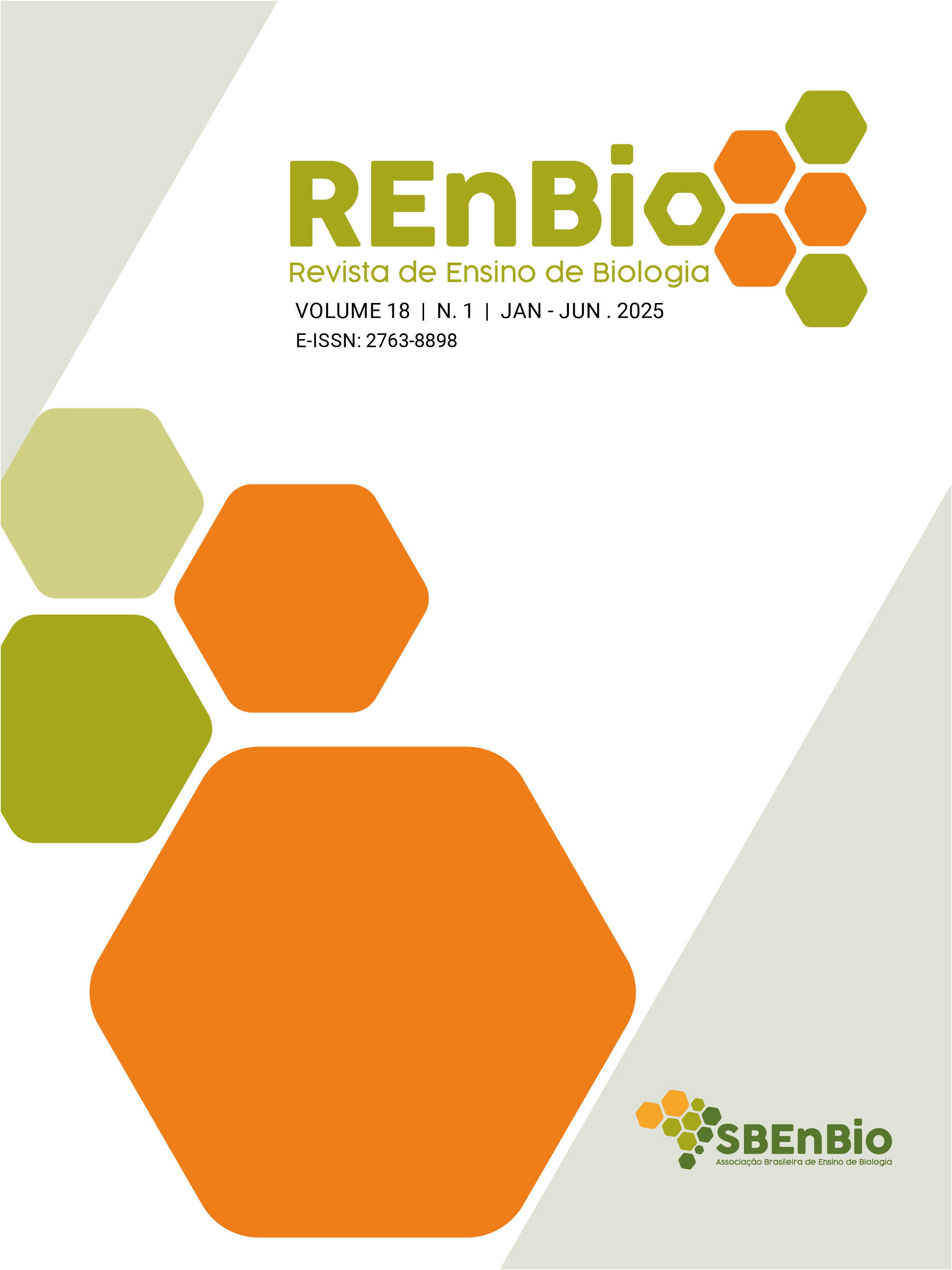MODELO DE RECONSTRUCCIÓN EDUCATIVA Y DESARROLLO DE SECUENCIAS DIDÁCTICAS RELATOS DE UN PROFESOR DE BIOLOGÍA EN FORMACIÓN INICIAL
Contenido principal del artículo
Resumen
Este informe de experiencia pretende describir las lecciones aprendidas por un profesor de biología en formación cuando participó en el proceso de elaboración de una Secuencia Didáctica (SD) sobre la cadena alimentaria, basada en el Modelo de Reconstrucción Educativa (MRE). Este modelo fue el marco teórico que guió el análisis de la práctica que aquí se pretende. Partimos de la idea de que el valor educativo de una SD, construida sobre los presupuestos teórico-metodológicos de la MRE, reside tanto en su potencial para organizar el trabajo docente, generando conocimiento y reflexiones sobre la práctica educativa; como en su potencial para favorecer la ampliación del repertorio de conocimientos de los estudiantes, en este caso, el conocimiento científico biológico. De modo que recurrimos a narraciones autobiográficas para relatar los episodios significativos de los tres momentos - antes, durante y después de la implantación de la SD - que caracterizaron la experiencia. Analizar los episodios a la luz del MER ayudó a tomar conciencia de los aprendizajes adquiridas en relación con la práctica profesional docente (por ejemplo, comprender el impacto de una buena planificación en el trabajo de un profesor; entender las concepciones de los alumnos como herramientas en los procesos de enseñanza y aprendizaje); y los adquiridos por mis alumnos, relacionados con la mejora de su comprensión de la cadena alimentaria (por ejemplo, comprender que el hombre forma parte de la cadena alimentaria; mejorar su comprensión de los productores y los consumidores). Además de apoyar el desarrollo de intervenciones educativas, el uso de los MER puede estimular la reflexión y la construcción de conocimiento sobre la práctica profesional docente.
Descargas
Detalles del artículo

Esta obra está bajo una licencia internacional Creative Commons Atribución-NoComercial-SinDerivadas 4.0.
Aviso de Direito Autoral Creative Commons
 https://creativecommons.org/licenses/by-nc-nd/4.0/
https://creativecommons.org/licenses/by-nc-nd/4.0/
Autores que publicam nesta revista concordam com os seguintes termos:
- Autores mantém os direitos autorais e concedem à revista o direito de primeira publicação, com o trabalho simultaneamente licenciado sob a Licença Creative Commons Attribution que permite o compartilhamento do trabalho com reconhecimento da autoria e publicação inicial nesta revista.
- Autores têm autorização para assumir contratos adicionais separadamente, para distribuição não-exclusiva da versão do trabalho publicada nesta revista (ex.: publicar em repositório institucional ou como capítulo de livro), com reconhecimento de autoria e publicação inicial nesta revista.
- Autores têm permissão e são estimulados a publicar e distribuir seu trabalho online (ex.: em repositórios institucionais ou na sua página pessoal) a qualquer ponto antes ou durante o processo editorial, já que isso pode gerar alterações produtivas, bem como aumentar o impacto e a citação do trabalho publicado (Veja O Efeito do Acesso Livre).
Citas
BARBOSA, M. D. C. P., SANTOS, J. W. M., SILVA, F. C. L., GUILHERME, B. C. O ensino de botânica por meio de sequência didática: uma experiência no ensino de ciências com aulas práticas. Brazilian Journal of Development, v. 6, n. 7, p. 45105-45122, 2020.
BRITO, O.L.O. Mobilização dos Pressupostos Teóricos e Metodológicos do Modelo de Reconstrução Educacional para a Construção de uma Sequência Didática sobre Cadeia Alimentar, Trabalho de Conclusão de Curso (TCC) - Universidade Estadual da Paraíba, Campina Grande, Paraíba, 2020.
DELMONDES, S. D. S; SOARES, A. L.; LIMA, F. J.; NETO,J. N. A., Programa Residência Pedagógica: Desenvolvimento de Sequência Didática sobre adição e subtração de numero inteiros no Ensino Fundamental. Anais IX CONEDU, Campina Grande: Editora Realize, 2023.
DUIT, R. et al. The Modelo of Educational Reconstruction – A Framework for Improving Teaching Science. In: JORDE, D, J. (Eds.).. Science Education Research and Practice in Europe: Restropertive and Prospective. [s.1] Sense Publishers, p. 13-38, 2012.
FREITAS, D.; GALVÃO, C. O uso de narrativas autobiográficas no desenvolvimento profissional de professores. Ciência &Cognição, v.12, p.219-233, 2007.
GIORDAN, M., GUIMARÃES, Y. A. F. E; MASSI, L. Uma análise das abordagens investigativas de trabalhos sobre sequências didáticas: Tendências no ensino de Ciências. Encontro Nacional de Pesquisa em Educação em Ciências, v. 8, p. 1-12, 2011.
GUNZEL, Rafaela Engers; DORNELES, Aline Machado; Investigação Narrativa (Auto)Biográfica como modo de Percepção da Constituição Docente Ambiental e Crítica. Revista Iniciação & Formação Docente da Universidade Federal do Triângulo Mineiro, v. 7, n. 4, 2020.
KOMOREK, M.; KATTMANN, U. The model of educational reconstruction. Four decades of research in science education–from curriculum development to quality improvement, p. 171-188, 2008.
LOPES, C. A. P.; BECKER-RITT, A. B.; AZAMBUJA, L. L. Gamificação na Educação De Jovens E Adultos (Eja): Ensino De Química Através De Sequência Didática Sobre Necrochorume. REAMEC - Rede Amazônica de Educação em Ciências e Matemática, Cuiabá, Brasil, v. 12, p. 24034, 2024.
LORENZETTI, L., COSTA, E.M.C. A promoção da alfabetização científica nos anos finais do ensino fundamental por meio de uma sequência didática sobre crustáceos. Revista Brasileira de Ensino de Ciênciasc e Matemática, Passo Fundo, v. 3, n. 1, p. 11-47, jan./jun. 2020
MÉHEUT, M.; PSILLOS, D.. Teaching–learning sequences: aims and tools for science education research. International Journal of Science Education, v. 26, n. 5, p. 515-535, 2004.
PRADO, H. V. Sequência Didática: uma possibilidade para ensinar e aprender Geologia nas aulas de Geografia.Trabalho de Conclusão de Curso (TCC) - Universidade Federal do Rio Grande do Sul (UFRGS), Porto Alegre, 2024.
SARMENTO, A. C. DE H. et al. Investigando princípios de Design de uma Sequência Didática sobre metabolismo energético. Ciência & Educação, v. 19, n. 3, p. 573-598, 2013.
TARDIF, Maurice. Saberes docentes e formação profissional. Editora Vozes Limitada, 2012.
TEIXEIRA, P. M. M.; MEGID NETO, J. A Produção Acadêmica em Ensino de Biologia no Brasil – 40 anos (1972–2011): Base Institucional e Tendências Temáticas e Metodológicas. Revista Brasileira de Pesquisa em Educação em Ciências, [S.l.], v. 17, n. 2, p. 521–549, 2017.
ZABALA, A. A prática educativa: como ensinar. Tradução Ernani F. F. Rosa. Porto Alegre. Artmed, 1998.

